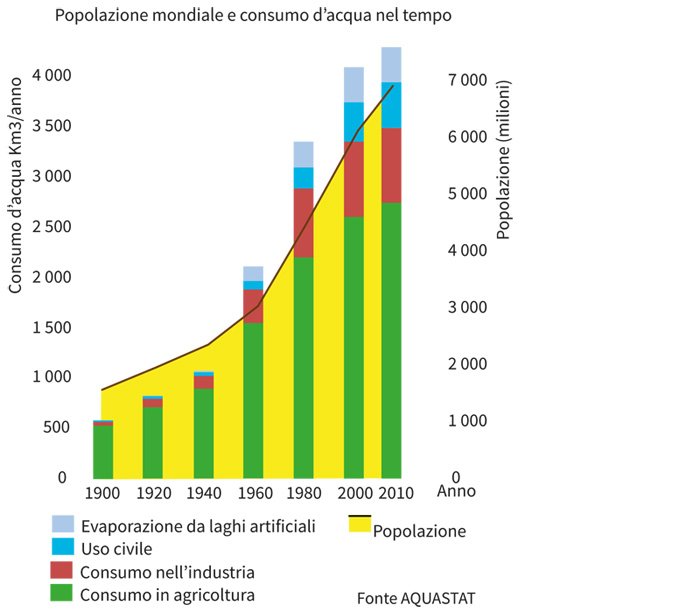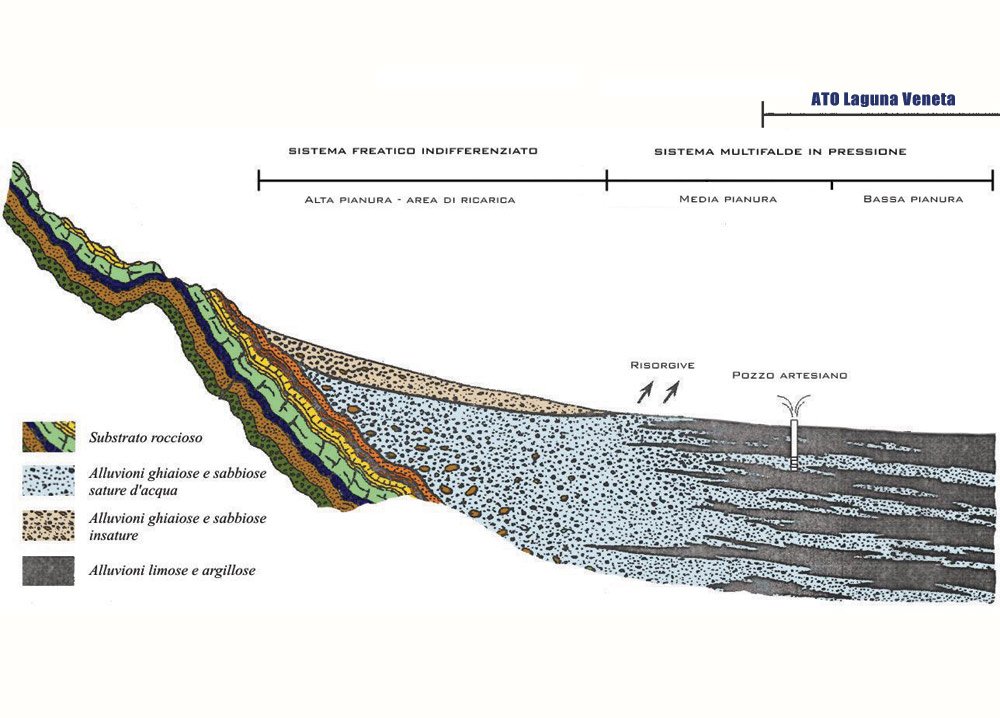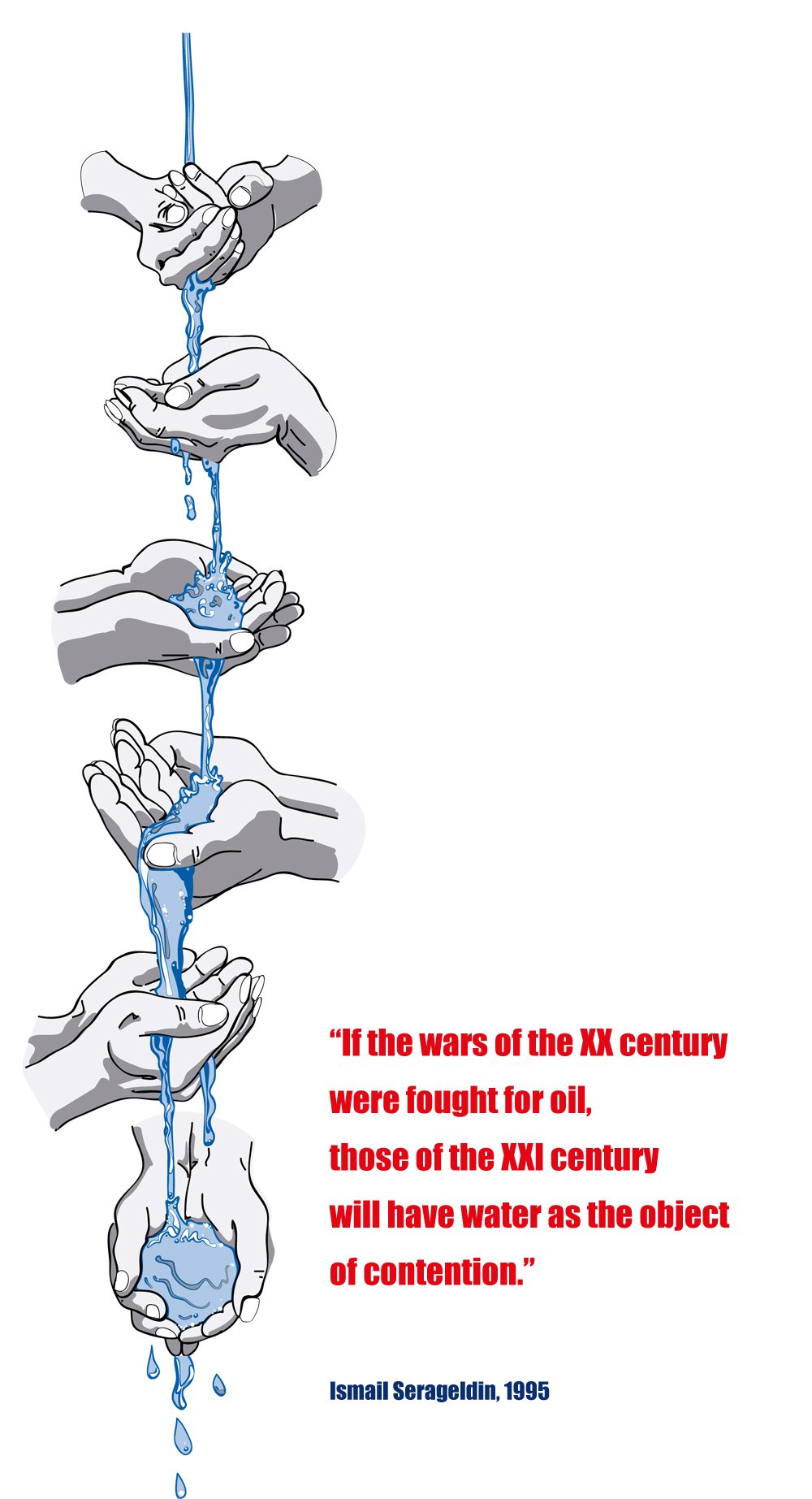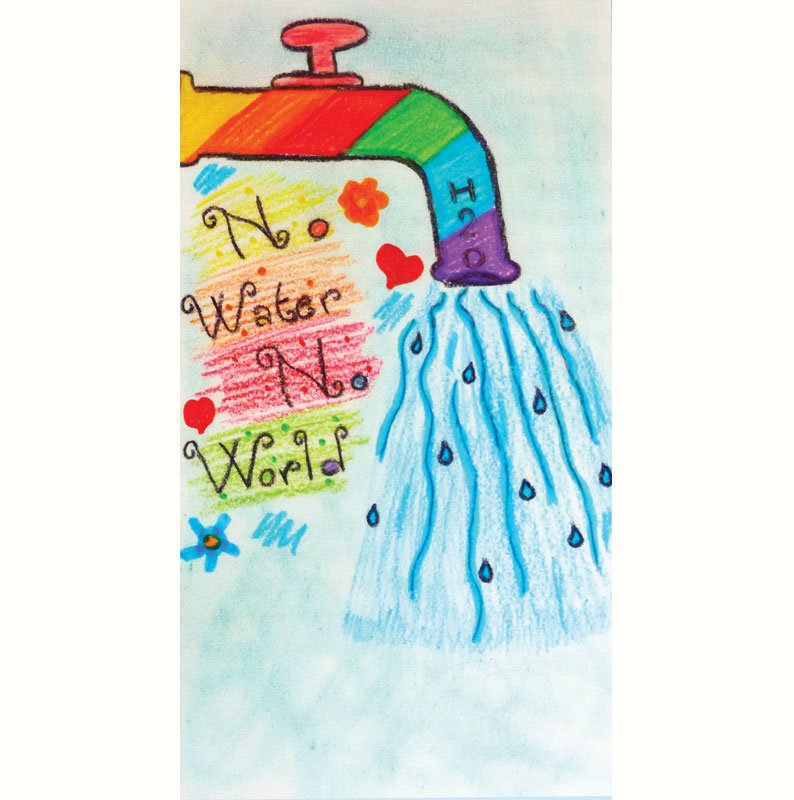“The water crisis is the dimension
more pervasive, more serious and less visible
of the ecological devastation of the Earth”
Vandana Shiva, 2004
QUANTITY AND DISTRIBUTION IN THE WORLD
Most of the water on our planet is contained in the oceans. As it is salted, it is not drinkable, therefore not potable and not suitable to be used for irrigation, except at very great expense. For all its activities, a minimal part of the water remains available to man, the fresh one, confined in underground deposits (aquifers) or accumulated in the form of surface water (rivers and lakes). These natural reservoirs are fed by water suspended in the air in the form of water vapor: clouds. Finally, a large reserve is present in the polar caps and glaciers of mountains in the solid state, but it is not available.
The fresh water available on our planet is less than a hundredth of the total water and this can become a serious problem if water management is not carried out with caution and thrift.
Another important fact is the unequal distribution of fresh water in the planet. 65% of the water resources of the planet is concentrated in fact within only 10 nations! An inhabitant of the United States, for example, has an average of 425 litres of water per day compared with 10 litres per day for an inhabitant of Madagascar. In Europe there are 237 litres of water per day available to an Italian on average, compared to 150 litres for a French.
The minimum per capita biological requirement for human survival is 5 litres of water per day for basic uses. However, the World Health Organization has stated that below the threshold of 50 litres of water per day there is suffering from lack of water. Today almost 1 billion people in the world do not have access to drinking water and another 2.5 billion (including 1 billion children) do not have access to sanitation, without which the potability of water cannot be preserved.
In the countries of the South of the World, 80% of all diseases are due precisely to water scarcity. Intestinal diseases, cholera and malaria, caused precisely by the lack of drinking water, cause an average of one dead child per minute (IMF, 2015).
Every year the lack of drinking water
Causes more victims than all wars!

Today, the water reserve is strongly impoverished at a global level, due to the over-exploitation of the aquifers and the consequent impossibility for them to regenerate. The water stress that afflicts the planet is mainly due to population growth, a factor that inevitably implies an exponential increase in the demand for water for all uses, from agriculture/industry to civil uses. If the basic water requirement per person is limited to about 5 litres per day, thousands are needed to produce the food we eat! [cfr. The water imprint]. To these must be added water that is used to produce the goods needed to meet the most common needs for living: clothes, objects, cars, mobile phones... In fact, any type of industrial production always needs water.
Every year there are 83 million more people on earth.(*) The increase in population means an increase in the production of goods and services that require more water and, as a result, more pollution. Freshwater consumption increased seven-fold between 1900 and 2010 (when the world population quadrupled).(**) At this rate, in ten years, 2/3 of the world's population will be forced to live in conditions of water emergency.
In addition to population growth, climate change has also increased: in the last twenty years, intense phenomena have increased, with longer periods of drought, more frequent and violent rainfall. Global warming, desertification and salinization of groundwater are consequential phenomena.
In some cases, the reduction of the water flow in the rivers, due to excessive draining in favor of agriculture and production activities, can prevent many watercourses from reaching the estuary, with the disappearance of entire wetlands! The increased nutrient load released in rivers by agriculture (especially nitrogen and phosphorus) causes eutrophication and asphyxiation in the fish that lives there.(***) Rivers should always be guaranteed a minimum quantity of water, called "minimum vital flow", beyond which the life of the river is irreversibly compromised. Watercourses, in fact, are themselves living organisms capable of forming natural processes of self-purification.(****) In any case, the first factor responsible for water scarcity in the world is the deterioration of water quality, due to cumulative industrial, agricultural and civil pollution.
(*) Today Earth is home to about 7,3 billion inhabitants; they were 1,6 billion a hundred years ago; according to estimates, we will be 8,5 billion within 2030 and 9,7 billion in 2050.
(**) The difference between the increase of water consumption and the growth of population can be explained by the global GDP (Gross Domestic Product) increase which grew over the same period by 27 times (FMI, 2015).
(***) Eutrophication is referred to the abnormal growth of aquatic plants, caused by a surplus of nutrients in agriculture, which reduces the oxygen dissolved in the water and causes asphyxia.
(****) Aquatic environments (rivers, ponds, swamps etc.) have a natural self-purifying power manifested in the ability to biologically decompose (biodegrade) organic substances deriving from animals, plants and some synthetic substances. This ability is due to the action of the micro-organisms present in the water, able to dismantel organic substances in the presence of oxygen. Phytodepuration uses the same concept for the treatment of civil waste water and uses plants (above all the marshy cane, which fosters the growth of these micro-organisms) as biologic filters.

The causes of water pollution are mainly related to the input of urban, industrial and agricultural effluents affecting both surface water and groundwater.
On average, industry uses 20% of the Earth's water resources. Water consumption in “advanced” countries is as high as 59%, compared to 8% in low-income countries. In addition, industry produces waste with a very high pollution load: heavy metals, solvents, toxic sludge, etc. In low-income countries, 80% of industrial waste is discharged in nature without prior treatment, fatally polluting valuable water resources.
Agriculture absorbs most of the planet's water resources: on average 70% of fresh water, even more in developing countries. Intensive agriculture can have a major impact on the environment through the use of pesticides, biocides, herbicides and fertilizers. There is therefore a risk that the percolation of these substances, year after year, if the process is not managed in compliance with the rules, could compromise the aquifers. In fact, correct irrigation methods could save huge amounts of water and a more reasonable use of pesticides would much better preserve the quality of aquifers.
Civil use absorbs 10% (15% in Italy) of water reserves. Sewage discharges from households contain organic substances and soaps that are polluting when discharged into the environment, sometimes reaching ground water. Thanks to sewage treatment plants, where they exist, this source of pollution can be significantly reduced.(*)
(*) Purification. The water used in our homes and then discharged through sinks, toilets, washing-machines and dishwashers reaches – through the sewarage – the waste water treatment plants where it goes under:
- mechanic pre-treatment, in order to separate and remove organic sedimentable substances (grilling, sandblasting, degreasing, primary sedimentation);
- Biological treatments to remove the organic substances through natural phenomena (the action of micro-organism acting in artificially created environments is exploited);
- Chemical or physical-chemical treatments, tp remove the pollutants thanks to chemical reactions (oxidation, neutralization), possibily associated with physical phenomena (adsorption, flocculation, stripping).
The pollutant component extracted from the wastewater through the sedimentation phases generates the sludge. Water is removed from the mud to reduce its volume; it is then stabilized and pathogenic organisms destroyed. Purified wastewater is finally reintroduced (watercourses or seawater), but can also be used for irrigation or in industry (reuse).

The water in our homes comes mostly from the subsoil through a long and complex path during which it purifies itself, reaching an excellent quality. However, its path is increasingly fraught with obstacles and its quality is irreparably degrading.

The sediments present in the subsoil derive mainly from the erosion of the rocks of the mountains and their transport downstream by the rivers. During the Ice Ages, most debris deposits and landscape modelling were carried out by glaciers and watercourses. The subsoil of the plain is not a homogeneous and uniform system as we are accustomed to believe; it is formed instead by several layers, more or less permeable, whose distribution determines important hydrogeological and landscape characteristics.
The Venetian plain can be schematically divided into three bands: the Upper Plain, the Middle Plain and the Lower Plain. The upper plain corresponds to the plain strip 10-20 km wide, which extends at the foot of the Alps. The heaviest and roughest materials (pebbles, gravel and sands), which are highly permeable, were deposited in it. In the middle strip of the middle plain, a few kilometres wide, permeable gravel and sandy layers follow one another in depth with other layers of thin, loamy and clay (not very permeable) materials. Here there is the so-called springs belt, from which the main Venetian spring rivers (Sile, Dese, Marzenego, Zero, etc.) are born, which flow into the Venice lagoon as a result of the water that spontaneously emerges from the ground. Finally, in the Lower Plain area, the furthest from the hills, thin materials (silt and clay) prevail, characterized by low permeability, alternating with layers of permeable material, thus generating very rich aquifers.
The territory of the "Lagoon of Venice" Basin Council is largely in the area of the Lower Plain. However, there is a portion of the territory (Scorzè, Noale, Quinto di Treviso, Zero Branco, Preganziol, Morgano) that belongs to the middle plain: a very important area for the abundance, quality and accessibility of the groundwater that is taken and used for various activities.
The process of groundwater pollution is due to the introduction of more or less soluble foreign products into the groundwater, which alter the chemical composition of the water and make it unsuitable for certain uses, if not highly harmful to human health (ISPRA, 2016).
Concentration limits for substances that may be present in water are set, in principle, by the World Health Organization (WHO). Groundwater, like surface water, can also be polluted, although it is difficult to reach in the Lower Plain, as it is protected by several layers of impermeable material (clay) on top of each other.
There are three types of water pollution:
- Microbiological pollution: this is due to the presence of bacteria, viruses and protozoa, some of which cause illnesses that can be serious for humans. Such pollution is generally absent in groundwater, as it undergoes natural filtration during its movement underground, which eliminates any micro-organisms harmful to human health;
- Chemical pollution: it is determined by chemicals. According to the EPA,1, thousands of chemicals have the potential to pollute water, but safety levels have not yet been established for all these substances. The main pollutants most frequently found in groundwater are: nitrates, nitrites, sulphates, chlorides, micropollutants (heavy metals, herbicides, solvents, benzene, vinyl chloride) and hydrocarbons;
- thermal pollution: this is caused by a rise in temperature, which reduces dissolved oxygen. Modern mini-hydroelectric plants, for example, cause this form of pollution; despite the proclaimed "green" energy they produce, they always have an impact on water.
In general, pollution is not very frequent in the middle and lower plains. But it can happen when chemical pollutants are released in the High Plain area, which is very permeable. In fact, the water that penetrates this area feeds the undifferentiated underground water basin which, in turn, feeds the aquifers of the Lower Plain.
We must not forget that, once created, groundwater pollution persists for a very long time, sometimes for very long periods.
There is no way to purify the aquifers except to take water and purify it. A process that is mostly titanic, often beyond the concrete possibilities of realization and too expensive. In many cases, for purification, we can only rely on nature, with its times that can be measured in hundreds or even thousands of years. Today polluted water will only become drinkable again in the very, very farther future. That is why we have to be very careful and do more prevention about how we use it. Maintaining quality water requires everyone's cooperation.
In the middle and lower plain areas of the provinces of Vicenza, Padua, Treviso and Venice there are many wells with spontaneous supply. The habit of letting the water continuously flow from the continuous jet fountains is deplorable and makes little sense. In this way, in fact, the water is dispersed and does not return to the aquifer from which it was taken. This is because the impermeable soils present in the first few metres of subsoil allow water to flow towards the surface network and, therefore, towards the sea or even into polluted soils. In short, these are unsustainable habits and behaviours: the use of a simple tap would save enormous quantities of water.(*)
In the area of higher collection of the ATO Lagoon of Venice,, from the approximately 5,000 private wells surveyed, a sufficient quantity of water is taken from the aquifer to feed an aqueduct capable of serving 1.5 million people!
(*) Current law forces the owner to previosuly communicate to the competent Authority the realization of a well and, consequently, the annual volume of water extracted. Moreover it obliges, for the collection carried out from the protected aquifers, to install adjusting devices able to prevent the continuous jet water release (Art. 40 of Technical Rules for the Implementation of the Water Protection Plan, DCR n. 107, of 5.11.2009).

Fresh surface or groundwater is a limited and vulnerable resource. Today, its availability continues to decrease due to unnecessary waste and increasing cumulative pollution. Water is therefore a depletable commodity. If it is true that its global quantity does not change, as the hydrologists explain, it is also true that the availability of good waters can change radically, even in a few years, due to senseless pollution.
In history, scarcity and uneven distribution have caused many wars for the control of water sources. The years to come will not be different. Some experts speculate, indeed, that an ever-increasing number of future conflicts will take place to grab the Blue Gold (no longer the black gold, which you can do without). Controlling Blue Gold will give enormous power precisely because the demand for water is constantly increasing globally, while the actual availability of good water is drastically diminishing.
“If the wars of the XX century were fought for oil,
those of the XXI century will have water as the object of contention.”
Ismail Serageldin, 1995

Some scientists have developed a method to calculate the amount of water that flows invisibly into our tables when we eat, or when we wear a pair of jeans or a t-shirt. It is called "Water Imprint" and considers, in addition to the water directly consumed to obtain a product, also that necessary to make this product available for consumption: from the procurement of raw materials to their processing, packaging, transport. In other words, the Water Imprint is the total volume of fresh water used to produce each good or service, measured in terms of volumes of water consumed (evaporated or incorporated into a product) and/or polluted (Hoekstra, Chapagain, 2011).
The Water Imprint is a discipline that allows today to determine the main indicators of environmental sustainability. Every single person, according to the Water Imprint, drinks on average 2 liters of water per day but consumes at least 5 if you calculate the one used for cooking and washing. If we then count the liters used for the production of the food he eats, human beings can use from 2,000 to even 5,000 liters per day of "virtual" water, depending on their diet. Similarly, you can calculate how much water a country exports or how much it imports, simply by considering what it produces. Italy, for example, is one of the countries that produces the greatest impact in terms of Water Imprint.

IN THE KITCHEN
• Wash dishes in a bowl (soaking the dishes facilitates cleaning). Use the cooking water of the pasta, which has a high degreasing and cleaning power.
• Only use the dishwasher when it is fully loaded. Many of these appliances use the same amount of water at half las at full load.
This will also save electricity.
• Repair water leaks, even the small ones. A leaking toilet or tap can lead to waste more than 100 litres of water per day!
• Use the flow reducer valve in every tab. The outgoing water will mix with the air and consumption will be reduced by up to 40%.
IN THE BATHROOM
• Replace the old toilet flushing cisterns with the differentiated flushing cisterns. 30% of household water consumption goes away with toilet flushing!
• When you take a bath you can use up to 150 litres of water, the equivalent of three showers.
• Close the tab when you shave, brush your teeth and do all those things that foresee downtimes before the rinsing. You can save up to 20 litres of water every time.
• Use the washing machine only when it is fully loaded, you will save up to 20.000 litres of water per year.
IN THE GARDEN
• Do not let water flush unnecessarily from wells or fountains!
• Water the plants during the evening hours, when the earth is less hot, It evaporates more slowly.
• Recycle the water used to wash fruits and vegetables for plants and flowers.
• Collect rainwater and use it for your garden.
• Install a drip irrigation system.
IN THE END…
• Use a bucket and not running water to wash your car. Thus you could save 80 litres of water per washing. Even better is the carwash that recycles dirty water.
• Water saving can be assured also through a good maintenance of seals, taps and pipes. A regular check of the counter will help you to notice possible leaks.
Some simple precautions to LIMIT THE POLLUTION of the water to be purified:
• Make sure that the cleaning products you buy are compatible with the environment (short biodegradable times, without phosphates). This will help to respect nature and to contribute to decrease purification costs
• Do not throw medicines, plastic or solvents into the sink or in the toilet.
• Do not disperse oils in the environment (1 liter oil makes 1 MILLION LITRES of water undrinkable!).
• Do not throw urban rubbish into the toilet, even small one such as: hair, cotton, cotton buds, medicines or chewing gum!

The project implemented by
Civiltà dell'Acqua

is supported
Water Agency 'Lagoon of Venice'
![]()
![]()
Text and graphic layout: Michele Cappellesso
Project coordination: Eriberto Eulisse